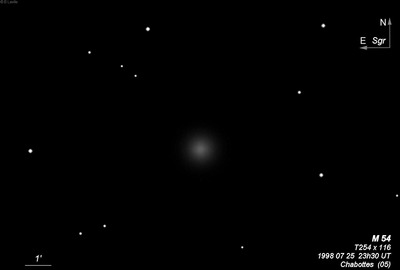
15x50mm IS binoculars (8/3/11): easily visible as a small fairly faint glow.
Charles Messier discovered M54 = D 624 = h3763 on 24 July 1778 and described a "very faint nebula, discovered in Sagittarius. It is bright in the centre and contains no star, seen with an achromatic telescope of 3.5 feet". On 24 Jun 1784 (sweep 232), William Herschel recorded "A round, resolvable nebula. Very bright in the middle and the brightness diminishing gradually, about 2.5' or 3' diameter. 240 power shews two pL stars in the faint part of the nebulosity, but I rather suppose them to have no connection with the nebula. I believe it to be no other than a miniature cl of v compressed stars resembling that near the 42nd Comae [M53]. It is like that under Delta Sagittarii [NGC 6624], but rather larger and brighter though not much."
James Dunlop found it "a very beautiful nebula, with a very bright round well-defined disk or nuclei, about 15 arcseconds diameter, surrounded by a gradually decreasing light or chevelure, about 1 1/4' diameter, this is exceedingly bright immediately at the centre." He made 4 observations of the globular and his published position is 28' east of center (not an unusually large error). John Herschel made several observations and noted on 1 Aug 1834 from the Cape of Good Hope, "Globular cluster; B; pL; vlE; gbM; 2 1/2' diam; resolved into st 15m, with a few outliers 14m."
M54 is the most distant Messier globular, roughly 85,000 light years away and lies close to the center of the Sgr Dwarf Spheroidal (SagDEG or Sgr dSph). M54 is thought to be the core of the disrupted galaxy but it has been proposed that it formed independently and plunged into the nucleus of the Dwarf as a result of the decay of its orbit due to dynamical friction.
400/500mm - 17.5" (8/2/86): very bright, fairly large, increases to a sharp bright core. Five brighter stars were easily visible around the edges, though these are probably field stars as the brightest cluster members are V = 15.5. The globular had a mottled, grainy appearance but there was no additional obvious resolution into stars. Easily visible in the 16x80 finder.
Notes by Steve Gottlieb